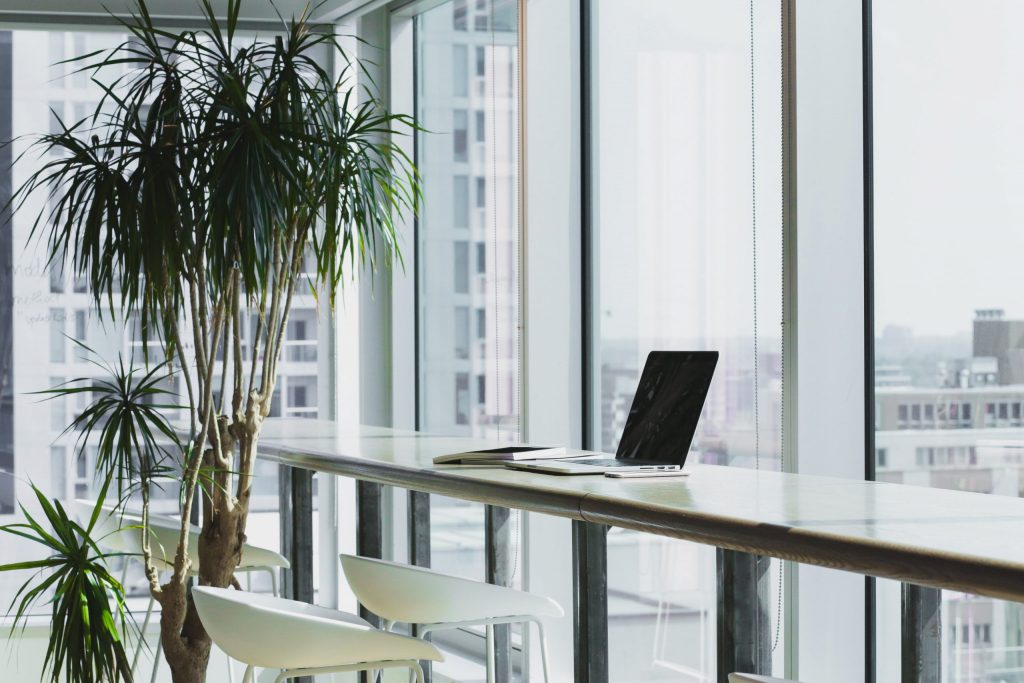July 27, 2022
The future of the office
We asked our in-house design team what they thought was important to consider for office design moving forward. Read on to find out what they think!
Natural lighting
Never underestimate the importance of lighting throughout the workplace – particularly the natural kind! Humans are drawn to natural lighting – it’s in our nature and helps regulate the body’s natural circadian rhythms.
Studies have shown that employees who are exposed to natural light in the office reported a drop in eye strain, headaches, and blurred vision – so if you can make the most and arrange your office to get the most from the natural lighting, do it! You may achieve this through encouraging daylight into most used areas, replacing solid partitions with glass and using materials that reflect light.
Not every office space has access to natural light, so that’s when our interior design team come in. They work with our clients to design clever lighting schemes – sometimes to mimic natural light.
We think lighting is definitely something worth spending time getting right. It impacts the way we work, happiness levels and productivity, so shouldn’t be overlooked!
Sustainability
Year after year, sustainability becomes a more important part of office design. The rising importance has seen an increase in projects submitting their design for certifications such as BREEAM and the WELL – something we’re familiar with, having worked on a project with a Platinum WELL accreditation.
There are many elements of an office where more sustainable options can be implemented. We’re conscious about suppliers, products, and materials we use – sourcing sustainable alternatives is a top priority for our interior designs and furniture specialists. On a recent project, the flooring we used was not only carbon neutral but contained 39% recycled content. Our trusted supply chain is also an important part of achieving more sustainability on site – when it comes to furniture, one of our main suppliers aims to prevent as many items as possible going to landfill and reupholstering / repurposing existing furniture.
As well as the physical elements in the office, it’s important to consider other aspects that can impact sustainability on a wider spectrum. Encouraging employees to use public transport or cycle to work is a top priority for a lot of employers, and as a result more clients are requesting showers, bike storage and lockers to be incorporated into the scheme.
Multipurpose workspace
I think we can all agree the events over the last couple of years has changed the office forever. Although we’ve seen a return to office for most businesses, many people are implementing hybrid working. Before the pandemic, most offices were designed to accommodate employees being there every day – something that’s quickly become out of date.
Collaborative workplaces aren’t a new concept, but with the changing landscape of the office and more flexibility around where employees may choose to work in the future, it is essential that these spaces unite employees and reignite company culture. This introduction of more casual areas has been described a ‘campus like’ – a space where staff are able to work together and look forward to going to, rather than an extension of the isolation they might feel working from home. This approach can take several forms, but often it involves moving away from the traditional 9-5 model and where individuals have their own offices or cubicles and an office environment that squeezes in the maximum number of workstations possible.
Instead, we are seeing a shift in focus to create open and flexible spaces that are better suited to activity-based working and tailored to how businesses operate and the new working styles of its employees. To develop a collaborative and flexible space, here at Workspace Design and Build, understanding how your employees work is integral our design proposals.
Variation of the workstation
- Location of fixed areas:
Our designers consider the locations of meeting rooms and tea points; can they sit within the heart of the workplace for multiple uses rather than being used in isolation by a small number of people? Can the tea point area become an informal meeting room space?
- A flexible layout:
Instead of walls, we consider temporary fixtures such as flexible partitions, furniture, acoustic panelling and even biophilic dividers which are an effective solution to divide people, activities and solutions that offer acoustic and visual privacy. The ability of the end solution to adapt with business evolution, with minimal disruption and cost, is critical to achieving long-lasting success.
- Choice:
The design of the office now needs to accommodate for individual needs and working styles of employees. These choices may extend far beyond furniture and setting but could include sensory variables such as lighting, noise, and temperature.
Looking to the future, we need to ask ourselves ‘what does the ‘office’ mean today?’
Everyday we are seeing companies embracing the office for being more than just a workplace, and more as physical identity of their culture and ideology.
Offices are becoming more like showrooms for the brand, rather than just somewhere people go from 9 to 5. Here at Workspace Design and Build, we love creating exciting and inspiring spaces that enable companies to make the change from a traditional ‘office’.
Get in touch to find out how we can make your office a multi-purpose, sustainable and attractive space where your business and employees can thrive.

